Citroen DS4 2016 1.G Owner's Manual
Manufacturer: CITROEN, Model Year: 2016, Model line: DS4, Model: Citroen DS4 2016 1.GPages: 436, PDF Size: 10.28 MB
Page 261 of 436
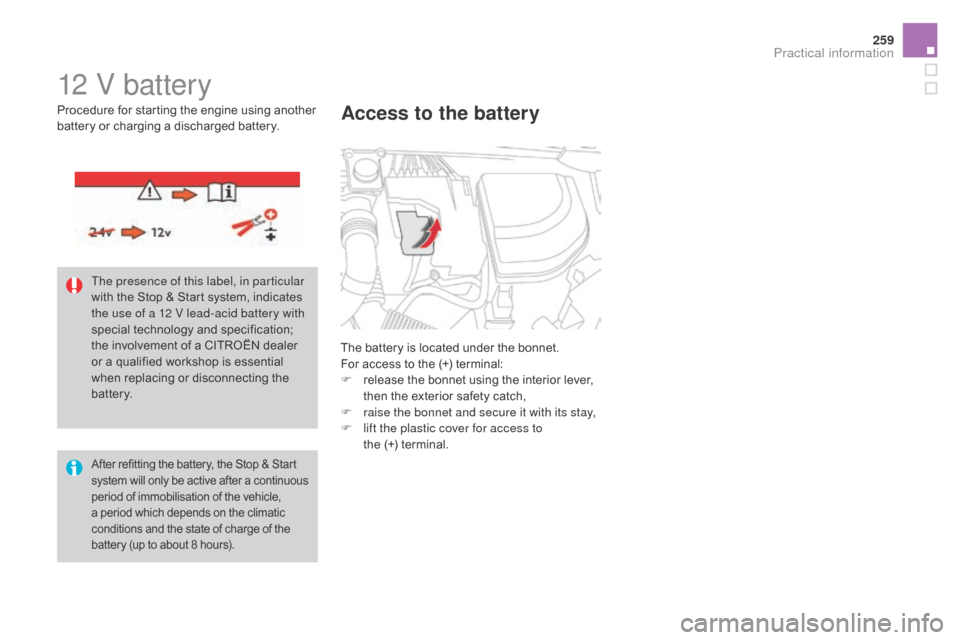
259
DS4_en_Chap09_info-pratiques_ed03-2015
12 V battery
The battery is located under the bonnet.
For access to the (+) terminal:
F
r
elease the bonnet using the interior lever,
then the exterior safety catch,
F
r
aise the bonnet and secure it with its stay,
F
l
ift the plastic cover for access to
the
(+) terminal.
Access to the battery
After refitting the battery, the Stop & Start
system will only be active after a continuous
period of immobilisation of the vehicle,
a period which depends on the climatic
conditions and the state of charge of the
battery (up to about 8 hours).
The presence of this label, in particular
with the Stop & Start system, indicates
the use of a 12 V lead-acid battery with
special technology and specification;
the involvement of a CITROËN dealer
or a qualified workshop is essential
when replacing or disconnecting the
battery.
Procedure for starting the engine using another
battery or charging a discharged battery.
Practical information
Page 262 of 436
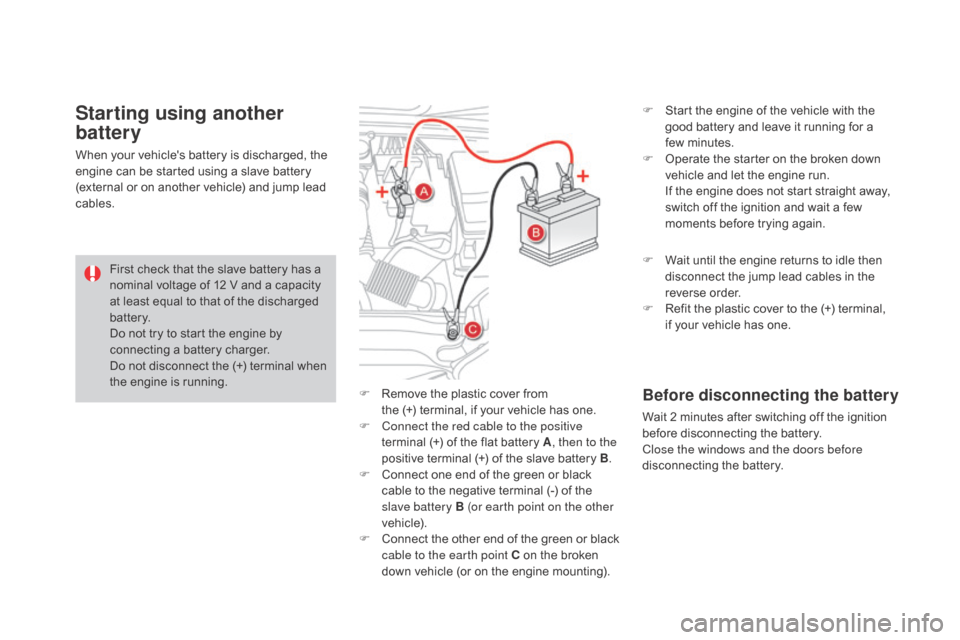
DS4_en_Chap09_info-pratiques_ed03-2015
F Remove the plastic cover from the (+) terminal, if your vehicle has one.
F
C
onnect the red cable to the positive
terminal (+) of the flat battery A , then to the
positive terminal (+) of the slave battery B.
F
C
onnect one end of the green or black
cable to the negative terminal (-) of the
slave battery B (or earth point on the other
vehicle).
F
C
onnect the other end of the green or black
cable to the earth point C on the broken
down vehicle (or on the engine mounting). F
S
tart the engine of the vehicle with the
good battery and leave it running for a
few
m
inutes.
F
O
perate the starter on the broken down
vehicle and let the engine run.
I
f the engine does not start straight away,
switch off the ignition and wait a few
moments before trying again.
Starting using another
battery
First check that the slave battery has a
nominal voltage of 12 V and a capacity
at least equal to that of the discharged
battery.
Do not try to start the engine by
connecting a battery charger.
Do not disconnect the (+) terminal when
the engine is running.
Before disconnecting the battery
Wait 2 minutes after switching off the ignition
before disconnecting the battery.
Close the windows and the doors before
disconnecting the battery.
When your vehicle's battery is discharged, the
engine can be started using a slave battery
(external or on another vehicle) and jump lead
cables.
F
W
ait until the engine returns to idle then
disconnect the jump lead cables in the
reverse order.
F
R
efit the plastic cover to the (+) terminal,
if your vehicle has one.
Page 263 of 436
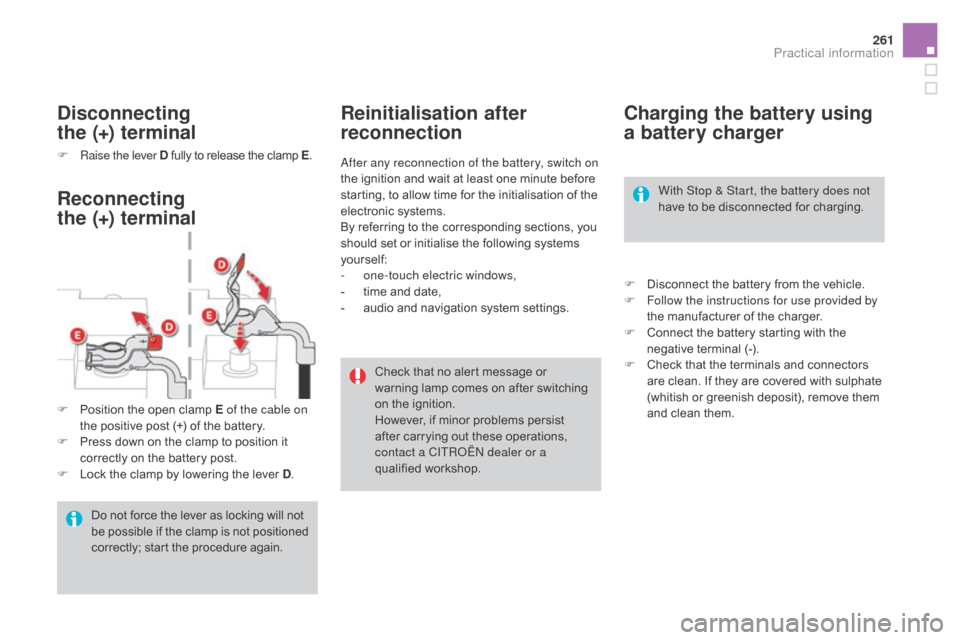
261
DS4_en_Chap09_info-pratiques_ed03-2015
Charging the battery using
a battery charger
F Disconnect the battery from the vehicle.
F F ollow the instructions for use provided by
the manufacturer of the charger.
F
C
onnect the battery starting with the
negative terminal (-).
F
C
heck that the terminals and connectors
are clean. If they are covered with sulphate
(whitish or greenish deposit), remove them
and clean them. With Stop & Start, the battery does not
have to be disconnected for charging.
Reinitialisation after
reconnection
After any reconnection of the battery, switch on
the ignition and wait at least one minute before
starting, to allow time for the initialisation of the
electronic systems.
By referring to the corresponding sections, you
should set or initialise the following systems
yourself:
-
o
ne-touch electric windows,
-
t
ime and date,
-
a
udio and navigation system settings.Check that no alert message or
warning lamp comes on after switching
on the ignition.
However, if minor problems persist
after carrying out these operations,
contact a CITROËN dealer or a
qualified workshop.
F
P
osition the open clamp E of the cable on
the positive post (+) of the battery.
F
P
ress down on the clamp to position it
correctly on the battery post.
F
L
ock the clamp by lowering the lever
d
.
Reconnecting
the (+) terminal
di
sconnecting
the (+) terminal
F Raise the lever d f ully to release the clamp E .
Do not force the lever as locking will not
be possible if the clamp is not positioned
correctly; start the procedure again.
Practical information
Page 264 of 436
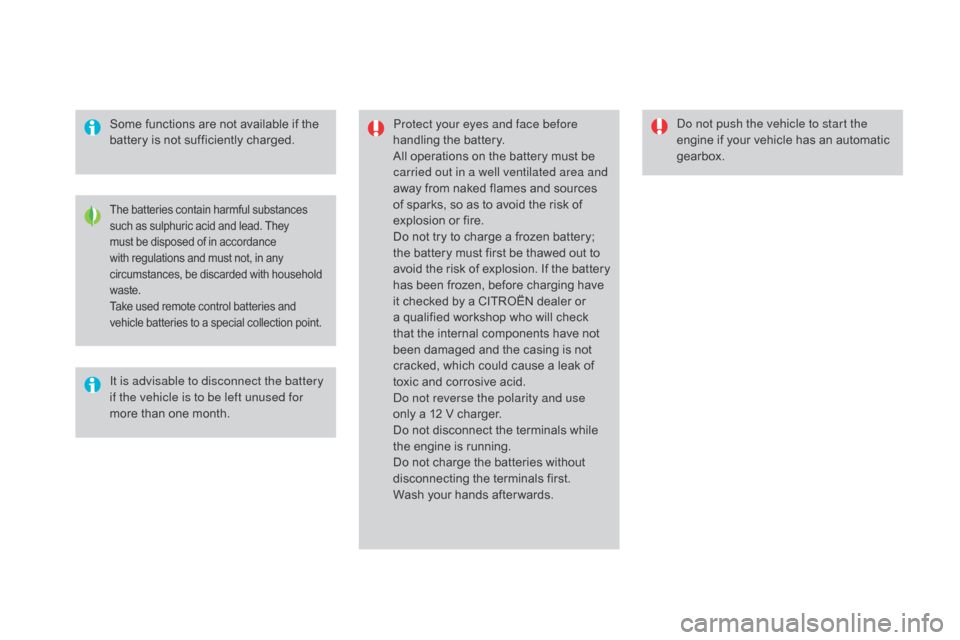
DS4_en_Chap09_info-pratiques_ed03-2015
Some functions are not available if the
battery is not sufficiently charged.Protect your eyes and face before
handling the battery.
All operations on the battery must be
carried out in a well ventilated area and
away from naked flames and sources
of sparks, so as to avoid the risk of
explosion or fire.
Do not try to charge a frozen battery;
the battery must first be thawed out to
avoid the risk of explosion. If the battery
has been frozen, before charging have
it checked by a CITROËN dealer or
a qualified workshop who will check
that the internal components have not
been damaged and the casing is not
cracked, which could cause a leak of
toxic and corrosive acid.
Do not reverse the polarity and use
only a 12 V charger.
Do not disconnect the terminals while
the engine is running.
Do not charge the batteries without
disconnecting the terminals first.
Wash your hands after wards.
It is advisable to disconnect the battery
if the vehicle is to be left unused for
more than one month.
The batteries contain harmful substances
such as sulphuric acid and lead. They
must be disposed of in accordance
with regulations and must not, in any
circumstances, be discarded with household
waste.
Take used remote control batteries and
vehicle batteries to a special collection point.
Do not push the vehicle to start the
engine if your vehicle has an automatic
gearbox.
Page 265 of 436
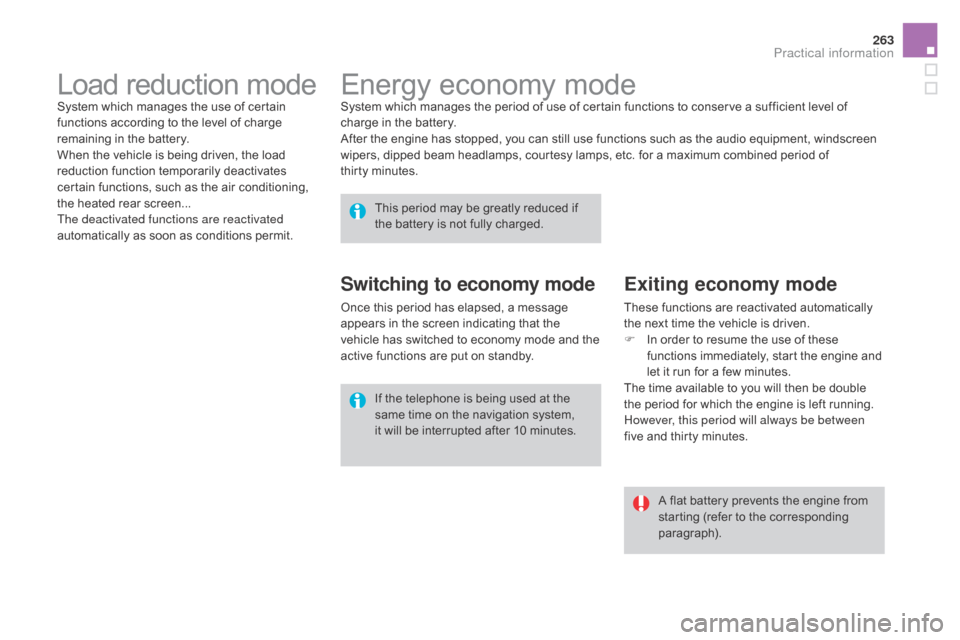
263
DS4_en_Chap09_info-pratiques_ed03-2015
Energy economy modeSystem which manages the period of use of certain functions to conserve a sufficient level of
charge in the battery.
After the engine has stopped, you can still use functions such as the audio equipment, windscreen
wipers, dipped beam headlamps, courtesy lamps, etc. for a maximum combined period of
thirty
m
inutes.
This period may be greatly reduced if
the battery is not fully charged.
A flat battery prevents the engine from
starting (refer to the corresponding
paragraph).
If the telephone is being used at the
same time on the navigation system,
it will be interrupted after 10 minutes.
Switching to economy mode
Once this period has elapsed, a message
appears in the screen indicating that the
vehicle has switched to economy mode and the
active functions are put on standby.
Exiting economy mode
These functions are reactivated automatically
the next time the vehicle is driven.
F
I
n order to resume the use of these
functions immediately, start the engine and
let it run for a few minutes.
The time available to you will then be double
the period for which the engine is left running.
However, this period will always be between
five and thirty minutes.
Load reduction modeSystem which manages the use of certain
functions according to the level of charge
remaining in the battery.
When the vehicle is being driven, the load
reduction function temporarily deactivates
certain functions, such as the air conditioning,
the heated rear screen...
The deactivated functions are reactivated
automatically as soon as conditions permit.
Practical information
Page 266 of 436
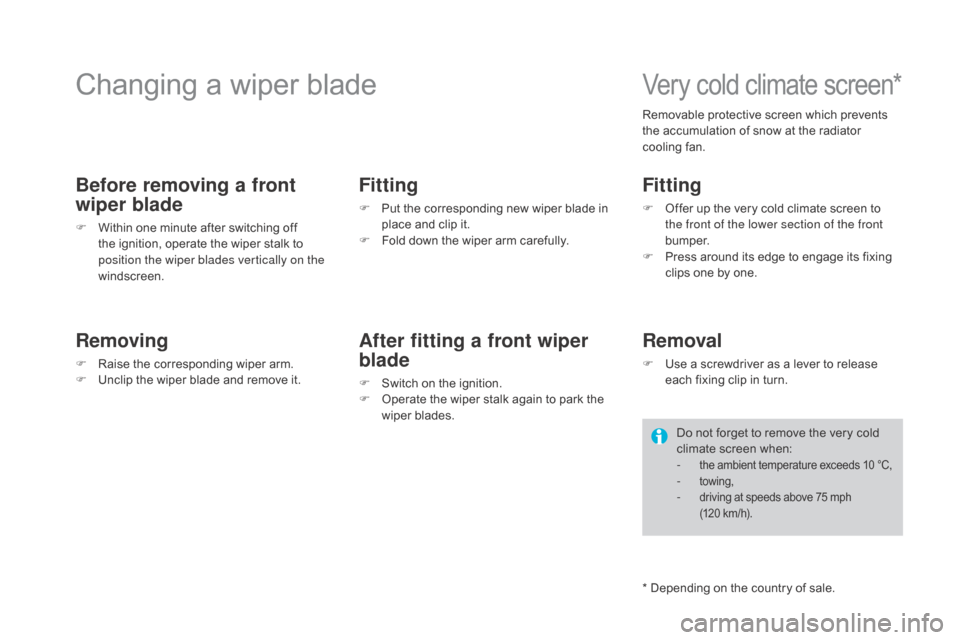
DS4_en_Chap09_info-pratiques_ed03-2015
Changing a wiper blade
Before removing a front
wiper blade
F Within one minute after switching off the ignition, operate the wiper stalk to
position the wiper blades vertically on the
windscreen.
Removing
F Raise the corresponding wiper arm.
F U nclip the wiper blade and remove it.
Fitting
F Put the corresponding new wiper blade in place and clip it.
F
F
old down the wiper arm carefully.
After fitting a front wiper
blade
F Switch on the ignition.
F O perate the wiper stalk again to park the
wiper blades.
Very cold climate screen*
Fitting
F Offer up the very cold climate screen to the front of the lower section of the front
b u m p e r.
F
P
ress around its edge to engage its fixing
clips one by one.
Removal
F Use a screwdriver as a lever to release each fixing clip in turn.
Do not forget to remove the very cold
climate screen when:
-
the ambient temperature exceeds 10 °C,- towing,- driving at speeds above 75 mph
(120 km/h).
Removable protective screen which prevents
the accumulation of snow at the radiator
cooling fan.
*
Depending on the country of sale.
Page 267 of 436

265
DS4_en_Chap09_info-pratiques_ed03-2015
Fitting roof bars
As a safety measure and to avoid damaging the
roof, it is essential to use the transverse bars
approved for your vehicle.When fitting roof bars, use only the four fixing
points located in the roof frame. The points are
masked by the vehicle doors when closed.
Remove the protective covers, levering them
off with a screwdriver. Take care not to scratch
the paint.
The roof bar fixings include a stud to be fitted to
the hole at each fixing point.
Observe the fitting instructions and the
conditions of use in the guide supplied with the
bars.
Keep the protective covers safe so that they
can be refitted after removing the roof bars. Maximum load distributed over the roof
bars, for a load height not exceeding
40
cm (except bicycle carriers):
-
f
or roof bars with pads at 90 mm:
50 kg
-
f
or roof bars with pads at 15 0 mm:
80 kg .
For more information, contact a
CITROËN dealer or a qualified
workshop.
If the height exceeds 40 cm, adapt the
speed of the vehicle to the profile of the
road to avoid damaging the roof bars
and the fixings on the vehicle.
Be sure to refer to national legislation in
order to comply with the regulations for
transporting objects which are longer
than the vehicle. Longitudinal roof bars are fitted as
original equipment to certain versions.
These play a purely aesthetic role and
transverse roof bars must not be fitted
to these longitudinal bars.
Practical information
Page 268 of 436
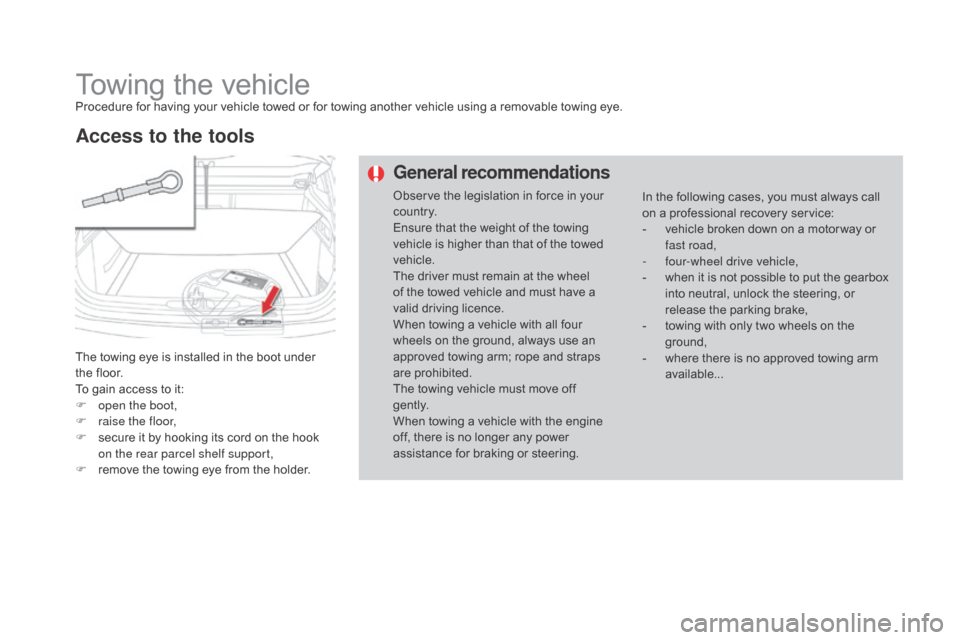
DS4_en_Chap09_info-pratiques_ed03-2015
Towing the vehicleProcedure for having your vehicle towed or for towing another vehicle using a removable towing eye.
The towing eye is installed in the boot under
the floor.
To gain access to it:
F
o
pen the boot,
F
r
aise the floor,
F
s
ecure it by hooking its cord on the hook
on the rear parcel shelf support,
F
r
emove the towing eye from the holder.
Access to the tools
General recommendations
Observe the legislation in force in your
c o unt r y.
Ensure that the weight of the towing
vehicle is higher than that of the towed
vehicle.
The driver must remain at the wheel
of the towed vehicle and must have a
valid driving licence.
When towing a vehicle with all four
wheels on the ground, always use an
approved towing arm; rope and straps
are prohibited.
The towing vehicle must move off
g e nt l y.
When towing a vehicle with the engine
off, there is no longer any power
assistance for braking or steering. In the following cases, you must always call
on a professional recovery service:
-
v
ehicle broken down on a motor way or
fast road,
-
f
our-wheel drive vehicle,
-
w
hen it is not possible to put the gearbox
into neutral, unlock the steering, or
release the parking brake,
-
t
owing with only two wheels on the
ground,
-
w
here there is no approved towing arm
available...
Page 269 of 436
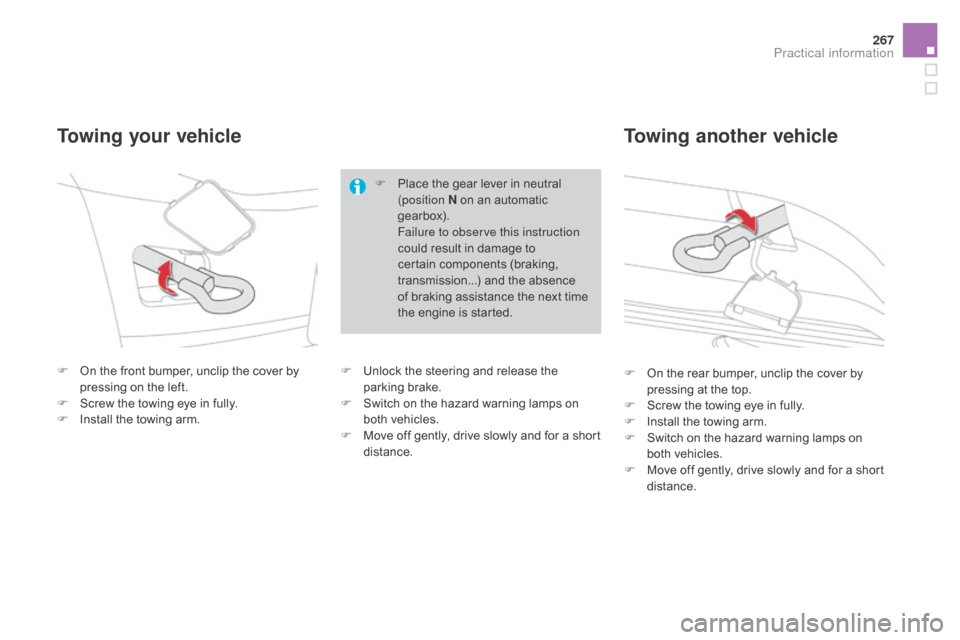
267
DS4_en_Chap09_info-pratiques_ed03-2015
F On the front bumper, unclip the cover by pressing on the left.
F
S
crew the towing eye in fully.
F
I
nstall the towing arm.
Towing your vehicle Towing another vehicle
F Place the gear lever in neutral
(position N on an automatic
gearbox).
F
ailure to observe this instruction
could result in damage to
certain components (braking,
transmission...) and the absence
of braking assistance the next time
the engine is started.
F
U
nlock the steering and release the
parking brake.
F
S
witch on the hazard warning lamps on
both vehicles.
F
M
ove off gently, drive slowly and for a short
distance. F
O
n the rear bumper, unclip the cover by
pressing at the top.
F
S
crew the towing eye in fully.
F
I
nstall the towing arm.
F
S
witch on the hazard warning lamps on
both vehicles.
F
M
ove off gently, drive slowly and for a short
distance.
Practical information
Page 270 of 436
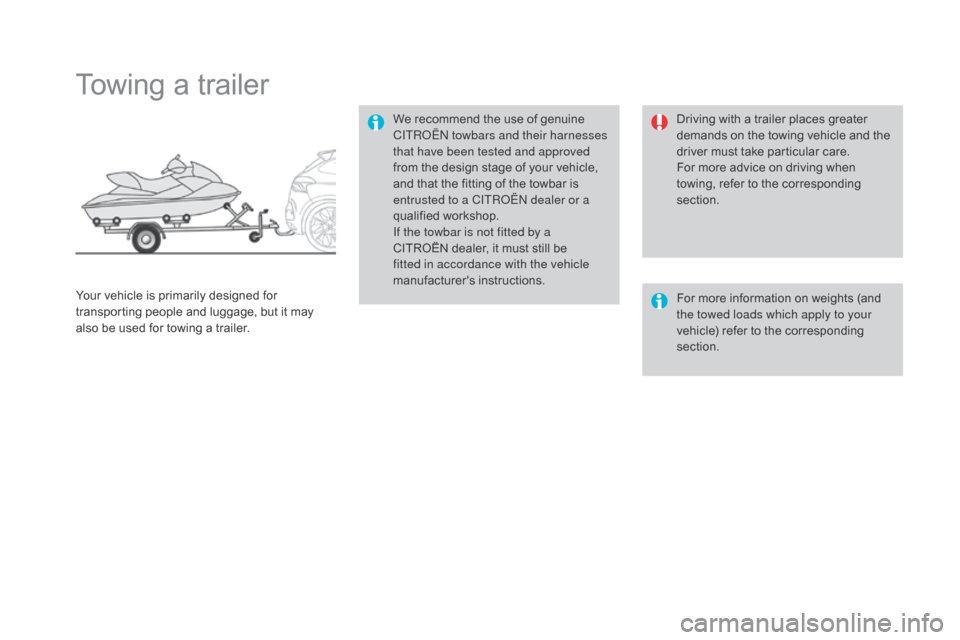
DS4_en_Chap09_info-pratiques_ed03-2015
Towing a trailer
We recommend the use of genuine
CITROËN towbars and their harnesses
that have been tested and approved
from the design stage of your vehicle,
and that the fitting of the towbar is
entrusted to a CITROËN dealer or a
qualified workshop.
If the towbar is not fitted by a
CITROËN dealer, it must still be
fitted in accordance with the vehicle
manufacturer's instructions.
Your vehicle is primarily designed for
transporting people and luggage, but it may
also be used for towing a trailer. Driving with a trailer places greater
demands on the towing vehicle and the
driver must take particular care.
For more advice on driving when
towing, refer to the corresponding
section.
For more information on weights (and
the towed loads which apply to your
vehicle) refer to the corresponding
section.